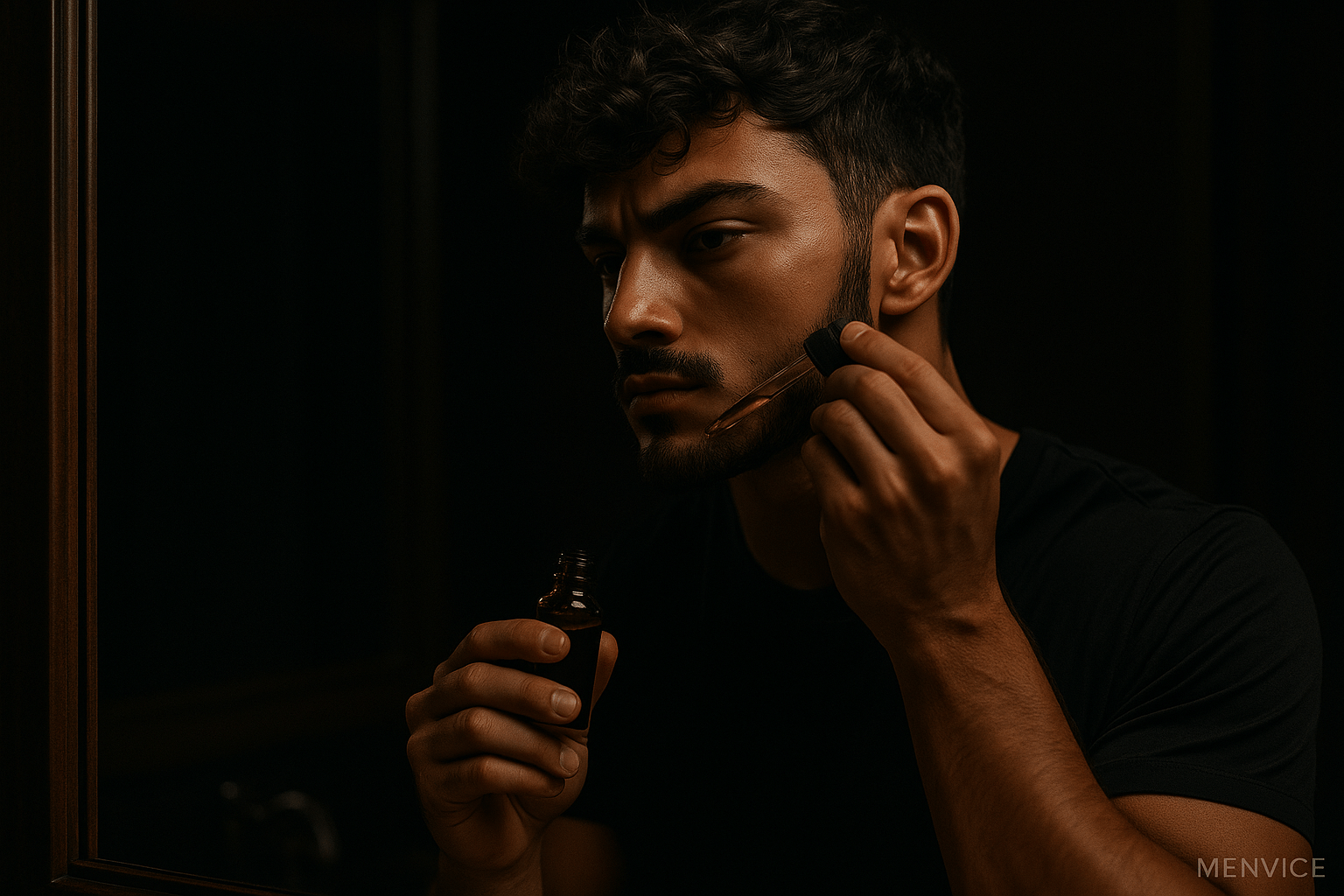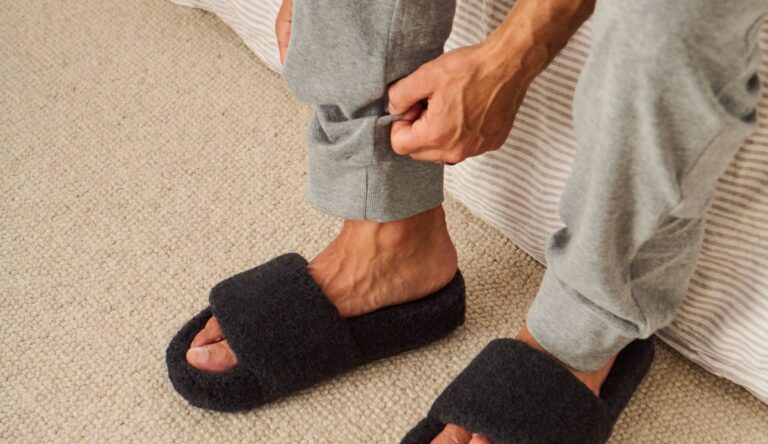
Elegance in Rebellion.
Own the Edge.
Why Your Beard Looks Weak (And the Masculine Fix You Need)

A beard isn’t just hair. It’s a signal. From ancient warriors who let their beards grow wild as marks of dominance, to philosophers who wore them as signs of wisdom, facial hair has always been more than fashion. Even today, when we like to think of ourselves as “modern” and “beyond symbols,” the truth remains: a man’s beard still says something about him the moment he enters a room.
When it’s thick, deliberate, and well-kept, it sends a message of vitality, maturity, and confidence. When it’s patchy, thin, or neglected, it tells a different story — one of weakness, carelessness, or lack of presence.
Men know this instinctively. That’s why so many either shave completely (avoiding the risk of a weak look) or spend years frustrated, waiting for their beards to “finally fill in.” But here’s the hard truth: a weak beard isn’t destiny. Most of the time, it’s the result of neglect, poor habits, or a lack of strategy.
Think about it. We don’t accept weak muscles as permanent. We train them, feed them, and build them up. The same principle applies to your beard. With the right approach — internal health, external care, grooming discipline, and a few smart tools — any man can transform his beard from something that drags him down into something that elevates him.
But before you can fix it, you need to understand why it looks weak in the first place. That’s where we start.
Why Your Beard Looks Weak
When men talk about their beard struggles, the first word that usually comes up is genetics. And yes, genetics play a role. But leaning on that excuse is the same as saying you’ll never build muscle because your father was skinny. The reality is, most “weak” beards aren’t purely genetic — they’re the result of specific, correctable factors. Once you know them, you can address them with precision.
Let’s break them down:
Patchiness
This is the most common complaint. The sides of the beard don’t fill in, or gaps appear around the cheeks and jawline. Patchiness often makes men give up early. But patchiness isn’t always permanent. Blood circulation, skin health, and nutrient levels all affect whether those follicles wake up or remain dormant. Many “bald patches” are just follicles waiting to be stimulated.
Thin Hair Strands
Even if your beard grows evenly, if the individual hairs are thin, the beard looks transparent and fragile. Imagine grass: sparse, thin blades versus thick, sturdy growth. Same soil, different strength. Thin beard strands usually come from poor nutrition, low testosterone, or lack of grooming care that protects the shaft of the hair.
Dryness and Poor Skin Health
Your beard grows out of your skin. If the skin underneath is dry, flaky, or inflamed, the hair that grows will reflect that weakness. This is why some men grow wiry, brittle beards that never seem to have weight or flow. The root is unhealthy, so the result looks unhealthy.
Hormonal Imbalance
Testosterone and DHT are key drivers of facial hair growth. If your lifestyle suppresses them—through stress, poor diet, lack of sleep, or excessive drinking—your beard pays the price. You may still grow hair, but it will be slower, thinner, and less dense.
Neglect
Even men with naturally strong beards can make them look weak by ignoring maintenance. Overgrown neck hair, stray cheek lines, uneven length—these small signs add up. Instead of looking rugged, the beard just looks sloppy. A beard should amplify your masculinity, not make you look like you don’t care.
The important thing here is this: most of these factors are fixable. Patchiness can be reduced. Thin hair can be thickened. Dryness can be reversed. Hormones can be supported naturally. And neglect is simply a matter of discipline.
When you look at your beard and think “weak,” understand that what you’re seeing is not a final sentence. It’s feedback. Your beard is telling you something about your habits, your health, and your level of care. And once you listen, you can take action.
The Masculine Fix System
A weak beard isn’t permanent. What you see in the mirror today is simply the sum of your current habits, health, and discipline. Just as a weak body can be trained into strength, a weak beard can be built into a masculine weapon. The fix isn’t one magic product or shortcut — it’s a system. A combination of feeding your beard from within, nourishing it externally, targeting weak spots, and maintaining it with discipline.
This system isn’t about looking like someone else. It’s about forging your best beard — the one that signals vitality, presence, and strength when you walk into a room.
Let’s break down each step.
1. Feed the Beard from Within
Your beard starts long before you see it. Hair is built from the nutrients in your bloodstream, and its growth is driven by your hormones. If your internal system is weak, your beard will always look weak.
- Protein is non-negotiable. Hair is made of keratin, a protein. Without enough protein, your beard strands will be thin and fragile. Aim for eggs, lean meats, fish, nuts, and legumes daily.
- Hydration fuels growth. Dehydrated skin produces dehydrated hair. Drink water as consistently as you train your body.
- Sleep builds testosterone. The deepest stages of rest release the hormones that fuel growth. Miss sleep, and you suppress the very signal that powers your beard.
- Strength training matters. Compound lifts like squats, deadlifts, and presses naturally boost testosterone and DHT, which directly support facial hair.
- How to Use: Take one tablet daily with water, ideally in the morning with food.
- Why It’s Needed: Biotin strengthens keratin, which thickens individual hair strands. A fuller beard isn’t just about more hairs — it’s about each strand being denser and more resilient.
- Who Should Use: Men with brittle, thin, or slow-growing beard hair.
- Alternatives: Eggs, almonds, and spinach provide biotin naturally, but supplementation ensures consistency and higher dosage.
Think of biotin as fuel. If your body is the engine, these nutrients are the high-octane gas that makes the machine run at full strength.
2. Nourish and Protect the Follicles
Your beard doesn’t just need internal fuel — it needs external protection. Follicles live in your skin, and the condition of that skin determines the strength of the beard.
- Wash your face with a mild cleanser; harsh soaps strip oils and suffocate follicles.
- Exfoliate once a week to clear dead cells and unclog growth pathways.
- Massage the skin under your beard daily to stimulate blood circulation.
GROWTH FACTOR Beard & Hair Growth Oil for Men
- How to Use: Warm a few drops between your palms, then massage into the beard and skin underneath. Do this once a day, ideally after a shower.
- Why It’s Needed: This oil directly nourishes follicles, providing moisture and active ingredients that support denser, healthier growth. It reduces brittleness, hydrates the beard, and prevents the wiry, weak look.
- Who Should Use: Men struggling with patchiness, dryness, or thin hair.
- Alternatives: Natural oils like castor or coconut oil can help, but they don’t offer the same targeted blend as beard-specific oils.
Beard oil isn’t vanity. It’s maintenance. Just like oiling a weapon prevents rust, oiling your beard protects it from weakness.
3. Target Weak Spots Directly
Some areas refuse to cooperate no matter how much you eat or oil your beard. These are the patches on your cheeks or jawline that look stubbornly empty. That’s where precision comes in.
Man Matters BeardGro Serum Roll On
- How to Use: Apply the roll-on directly to patchy spots once or twice daily. Leave it to absorb into the skin without rinsing.
- Why It’s Needed: While oils work broadly, this serum is designed for targeted stimulation. It activates follicles in problem areas, encouraging new hair growth where none seemed possible.
- Who Should Use: Men frustrated by bald patches or uneven density.
- Alternatives: Dermarolling is an advanced technique that uses micro-needles to stimulate follicles. It works but requires care. A serum roll-on is simpler and safer for most men.
Weak spots aren’t permanent. They’re simply areas that need extra attention. Think of them as lagging muscles — train them specifically, and they’ll catch up.
4. Discipline Through Grooming
Here’s where many men fail. They buy oils, supplements, and serums — then let their beard run wild. Even the thickest beard looks weak if it’s unmanaged. Grooming isn’t about vanity. It’s about discipline. A well-kept beard signals control, while a sloppy one signals neglect.
- Trim stray hairs weekly.
- Keep the neckline sharp. Nothing ruins a beard faster than uncontrolled neck fuzz.
- Define the cheek lines — whether high or low, they should look deliberate.
- Maintain even length. A lopsided beard makes the whole face look off.
Beardo Chrome Beast Multipurpose Groomer
- How to Use: Use it once a week to trim edges, shape cheek and necklines, and maintain your preferred length. Adjust attachments based on style.
- Why It’s Needed: Precision matters. A rugged beard can look masculine, but a messy one looks careless. This tool ensures your beard looks intentional.
- Who Should Use: Every man with facial hair — from light stubble to full mane.
- Alternatives: Professional barbers can shape your beard, but daily or weekly maintenance requires a reliable trimmer at home.
A groomed beard doesn’t hide weakness. It prevents it.
5. Match Beard Style to Your Face
Not every man needs a lumberjack beard. The strongest beard is the one that complements your bone structure. When you align beard style with face shape, even a moderate beard can look powerful.
- Square faces: Full beards or boxy styles balance the jawline.
- Round faces: Longer chin hair with shorter sides creates definition.
- Oval faces: Almost any beard works, but neatness is non-negotiable.
The point is simple: don’t copy another man’s beard. Build yours for your face. Masculinity isn’t imitation; it’s precision.
With this system in place — internal health, follicle care, targeted growth, grooming discipline, and style alignment — any man can transform his beard. Weakness isn’t permanent. It’s simply the result of neglect, and neglect can be corrected with action.
The Masculine Philosophy of Beard Building
A beard is never just a beard. It is one of the few physical traits a man can control that immediately changes how the world sees him. Haircuts, clothes, and watches all make a difference, but a beard has a different weight. It’s primal. It signals maturity, vitality, and even dominance in a way nothing else does.
When your beard looks weak, people may not consciously analyze it, but they feel it. They register a lack of strength, energy, or discipline. In the same way, when your beard is strong and deliberate, people sense presence. They know, instinctively, that you are a man who takes care of himself, who invests in the details, who controls his appearance instead of letting it control him.
This is why beards have always been tied to masculine identity across cultures. The Spartans wore them as symbols of war readiness. Philosophers kept them as marks of wisdom. Even today, CEOs, leaders, and men who want to project authority often choose well-maintained beards over baby faces. It’s not about fashion — it’s about image, power, and perception.
But here’s the deeper layer: your beard is not only about how others see you. It’s about how you see yourself. The process of building and maintaining a strong beard is itself an act of discipline. It forces you to pay attention to health, grooming, and consistency. It trains you to treat small things with respect — and in life, how you do the small things is how you do the big things.
A man who can’t discipline himself to care for his beard will struggle to discipline himself elsewhere. On the other hand, a man who treats his beard as a ritual — fueling his body, nourishing his skin, grooming with precision — trains the same mindset he can apply in the gym, at work, or in his relationships.
This is the real philosophy: your beard is a mirror of your masculinity. Weakness in the beard reflects weakness in discipline. Strength in the beard reflects strength in lifestyle.
And when you build a beard with intention, you’re not just growing hair. You’re shaping a signal — to the world, and to yourself — that you are a man in control.
The MenVice Daily Beard System
Every strong beard is built on consistency. Just like strength training, it isn’t about one heroic session in the gym — it’s about showing up every day, doing the work, and letting the results compound. Your beard is no different.
Here’s a daily and weekly system designed for men who want a beard that looks deliberate, masculine, and powerful.
Morning Ritual
Start the day by treating your beard like you treat your body. When you wake up, your face is dehydrated and your beard is rough from friction during sleep.
- Cleanse: Rinse your face with cool water and a mild cleanser. Avoid harsh soaps; they strip the oils your beard needs to stay strong.
- Hydrate: Pat your face dry (never rub), then apply beard oil. This locks in moisture and nourishes both the hair and the skin beneath.
👉 Use GROWTH FACTOR Beard & Hair Growth Oil for Men. Massage it in slowly, working it into the skin under the beard. This isn’t just about shine — it’s about strengthening the follicle environment so growth looks denser over time.
Think of this as setting the foundation. Just as a soldier checks his gear before battle, a man should prepare his beard before stepping into the world.
Midday Discipline
At this point, the focus shifts from external care to internal fuel. Your beard reflects what you eat, drink, and do during the day.
- Hydration: Keep water intake steady. Dehydration leads to dryness, which weakens hair.
- Nutrition: Make sure lunch is protein-centered — chicken, eggs, legumes, or fish. Pair with greens for natural biotin and vitamins.
- Stress Check: Stress raises cortisol, which lowers testosterone. Take five minutes mid-afternoon to breathe deeply, stretch, or step outside. Your hormones — and your beard — will thank you.
👉 Consider taking Be. Handsome Biotin Tablets with your meal. This isn’t a quick-fix pill — it’s a consistency tool. Daily intake strengthens your beard at the molecular level by improving keratin production.
Evening Reset
The evening is where you prepare your beard to recover and grow overnight. This is crucial — just like muscles repair during sleep, your beard responds best when you prime it before rest.
- Target Patchy Spots: Apply Man Matters BeardGro Serum Roll On directly to areas that refuse to fill in. Consistency here is critical; most men quit after a week or two. Growth takes months, but this ritual keeps you on track.
- Massage & Relax: A quick one-minute massage of the serum into the skin improves circulation, ensuring follicles get the nutrients they need.
- Sleep with Intention: Aim for 7–8 hours. Growth hormone and testosterone peak during deep sleep, and this is when your beard actually thickens.
Weekly Warrior Routine
Daily care builds strength, but weekly rituals shape the final look. Without these, even a healthy beard can look weak.
- Exfoliate Once a Week: Use a gentle scrub to remove dead skin under the beard. This keeps follicles unclogged and prevents ingrown hairs.
- Trim & Shape: Take out the Beardo Chrome Beast Multipurpose Groomer once a week. Define your cheek lines, sharpen the neckline, and clean stray hairs. This is where intention shows. Rugged doesn’t mean sloppy — it means deliberate.
- Check Style Alignment: Look at your beard in the mirror and ask: Does this match my face? Adjust length or shape to fit your bone structure. A beard that works with your face always looks stronger than one that works against it.
The MenVice Weekly Schedule (Snapshot)
- Daily Morning: Cleanse → Beard Oil.
- Daily Midday: Hydration → Protein → Biotin Tablet.
- Daily Evening: Target weak spots with Serum → Massage → Sleep.
- Weekly: Exfoliate → Trim with Groomer → Adjust style.
This system doesn’t require hours of effort. It requires minutes a day and discipline every week. Over time, the results build into something undeniable.
The Closing Strike
Look at your beard right now. Is it sending the message you want it to? Or is it selling you short?
A weak beard is not just weak hair — it’s a reflection of weak habits, poor discipline, and neglect. A strong beard, on the other hand, is a signal. It tells the world that you are a man who respects himself, who pays attention, who takes the time to sharpen his presence.
You now have the system. Fuel your body with real nutrition. Fortify growth with oils and serums. Lock in consistency with biotin. Train your beard the way you train your muscles — with care, pressure, and discipline. And when it grows, control it. Shape it. Make it deliberate.
Remember this: a beard is not grown, it is forged. It is built like iron — through pressure, time, and fire. The man who commits to this process will never look weak again. His beard will speak for him before he opens his mouth.
Forge your beard. Forge your presence. Forge yourself.






